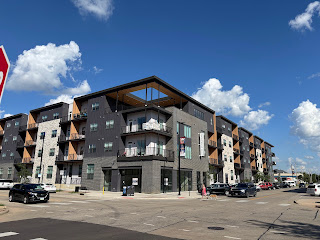 |
| Are there "antifragile" ways to develop this city-owned property? |
"Basically, by 2030," he goes on, "it's reasonable to assume that most of the cars on the road will have some level of automation. What does a world where most cars can drive [and park] themselves look like?" Well, for one thing, all those garages and parking lots would still have all the negatives identified by the prophet Donald Shoup (chunks of unproductive and unattractive space, missing teeth on the street, generally killing the urban buzz) with none of the positives (individual convenience, sends a message that people from away are welcome).
Meanwhile, the Strong Towns Book Club, in its discussion of book 3 in philosopher Nassim Nicholas Taleb's provocative Antifragile (Random House, 2012), asks: How would a local government use the barbell strategy (embracing both extreme risk aversion on one side and extreme risk taking on the other while shunning everything in the middle)? As applied to the parking dilemma, how does a city struggle to balance the expectations of drivers with the needs of productive places and the people who use them, when fast-paced technological change may soon upend the basic realities on which such assessments are built?
Taleb in book 3 builds on his concept of antifragility, the idea that success means more than riding out the bad stuff (mere "robustness" or "resilience"); it should mean becoming stronger from adversity. He introduces us in chapter 9 to two lovable characters, each of whom stands for an important aspect of the antifragile life. "Fat Tony" DiBenedetto has a strong antipathy toward "the empty suit" (p. 145) and "believed that nerds, administrators, and, mostly, bankers were the ultimate suckers" (p. 147) because they master the details that are essentially superfluous while missing the big important things. The restlessly curious Nero Tulip recognizes some stuff doesn't make sense even when intellectuals purport to explain it, and so "a system built on illusions of understanding probability is bound to collapse" (p. 147). Both men made money from the financial collapse of 2008 because they recognized the pretense behind all the smart people saying they had things under control, so they had made investments that bet against the smart people's predictions.
Fat Tony and Nero teach us that we, individually or collectively, don't know as much as we think we do, and so life choices and public policies that assume much knowledge of the future are attended by great downside risks when the inevitable unexpected events develop. The antifragile path, we learn in chapter 11, is rather to let go of detailed predictions based on statistical metrics (which with their false precision are "just air" [p.150]) and focus on avoiding the major downside risks that could lead to collapse. This frees the individual to take occasional flyers on high risk activities that have the potential for major payoffs. Uniformly medium risk still carries the chance of complete failure, so go for "a dual strategy composed of extremes, without the corruption of the middle"--the barbell metaphor--"somehow they all result in favorable asymmetries" (p. 162).
So how do we "barbell" our downtowns? The presence of autonomous cars on the time horizon can in this sense be a blessing to city officials and business leaders, because it frees all of us from any idea how this is going to play out, like knowing how many parking spaces we're going to need. Let go, say Fat Tony and Nero, of the models showing how downtown is going to develop in the next 15-30 years, because they're all surely wrong in some important way or other. Focus instead on the worst that can happen--what would constitute catastrophic failure?--and avoid that outcome(s).
For cities catastrophic failure would either be financial insolvency or being saddled with a large amount of useless space, which are probably correlative anyway. In the specific case of Cedar Rapids we could add massive property damage from another flood on the scale of 2008. So you don't want to invest so much in infrastructure that you can't afford to maintain, and you don't want to take a form that can't adapt to changing circumstances and fashions. I think that if we develop with too little parking--stop laughing! and follow my argument here--such a mistake would not be catastrophic; things would work themselves out because the rising value of parking space would impel some developer to invest in creating more of it. If instead we choose too much parking, that has great downside risk: it winds up being expensive to someone, which ultimately means the municipality once the businesses fail or flee. An excess of space devoted to parking means vast emptinesses at street level, which severely handicaps the area's ability to attract residents, businesses and visitors.
In positing near-term major change in people's behavior, Ben complicates the scenario by asking what happens if we miraculously get the parking right for 2016 but in 15 years it turns out to be way too much? That would lead to failure if all that parking can't be inexpensively converted to some more productive use. So just as we should construct buildings that can be converted to a succession of uses--this...
not this...
...we should design at least some of those parking facilities for flexible use, too. Could, for example, a parking garage with excess capacity be made to shrink from the outside in, so there could be shops on the street side? Approaching it like that seems to me to be the city's essential interest, while we leave the details up to the market.
SEE ALSO:
Ben Adler, "Cities Finally Realize They Don't Need to Require So Much Damn Parking," Grist, 2 August 2016
Ben Kaplan, "What Happens After Autonomous Cars?" Corridor Urbanism, 4 August 2016
EARLIER PERTINENT POSTS:
"Can Regional Planning be Antifragile?" 31 May 2016
"Downtown vs. Parking," 29 September 2013"The Parking Dilemma," 31 July 2013









No comments:
Post a Comment